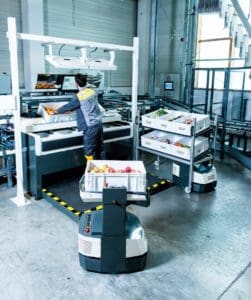![]() I am writing this post from Orlando, FL, where I am attending JDA Focus 2018. The theme of the conference was “Expectations. Fulfilled.” and based on some of the new product strategies that were announced, it seems to be an appropriate theme. The big news from the conference was the launch of the JDA Luminate Platform, a connected platform that combines next generation digital technologies with product enhancements to JDA’s core solutions.
I am writing this post from Orlando, FL, where I am attending JDA Focus 2018. The theme of the conference was “Expectations. Fulfilled.” and based on some of the new product strategies that were announced, it seems to be an appropriate theme. The big news from the conference was the launch of the JDA Luminate Platform, a connected platform that combines next generation digital technologies with product enhancements to JDA’s core solutions.
I talked with the JDA team a number of times about the impact of Luminate, and where they see the platform going. Essentially, the platform is going to bring in edge technologies and real-time data sets to every node within the supply chain. This includes the Internet of Things (IoT), artificial intelligence, machine learning, and social media, news, events, and weather (SNEW) data. The goal is to have real-time, actionable data available to make better decisions across the entire network. This will eliminate the need for batch updates which only give a snapshot in time rather than a real-time look at inventory, transportation, etc.
There are two key characteristics of JDA Luminate that should be noted. First, Luminate includes brand new, net new products. These products are designed for real-time decision making, leveraging an assortment of data streams. The three new products are Luminate Control Tower, Luminate Assortment (which is an enhancement and renaming of Retail.me), and Luminate Store Optimizer. And second, JDA’s existing core products will be enhanced with the technology. These enhancements will be add-on services that customers can choose. While the company has developed roadmaps for each of these enhancements, the enhancements will likely take place on the normal maintenance path of existing core applications.
JDA also set out to ensure that the new products would resonate with customers. To that end, the company did not develop Luminate in isolation. Instead, as JDA CEO Girish Rishi noted, customers were part of the development process. JDA worked with two to five customers on the new initiatives. This enabled the company to have measured value when the products were released. It also ensured that they did not build key pieces of functionality that did not meet customer expectations; instead, the functionality was developed in conjunction with actual customers, which should make the applications more appealing.
From what I saw, a few of the Luminate products stood out to me. JDA Luminate Control Tower is a centralized mechanism for analyzing digital, real-time, granular data. The application addresses inventory visibility and supply chain disruptions. It will be the foundation of all data science for JDA, and utilizes machine learning for prescriptive decision making. JDA Luminate Demand uses machine learning to develop highly accurate forecasts. The solution brings in additional information such as SNEW data to make decisions. JDA Luminate Store Optimizer looks to build out the store’s capabilities in the omni-channel environment. The application dynamically merchandises individual stores, starting with shelf-level hygiene and better inventory accuracy. It also prioritizes tasks within the store, so associates are able to work more efficiently.
JDA also had some exciting news around its partner network. As visibility has become more important, the partnerships JDA is focusing on reflect this. One such partner is Fourkites, a company that offers a real-time supply chain visibility and predictive analytics platform with more than four million GPS/ELD connected devices. The company has launched Predictive Capacity Management (PCM). This offering can predict when a truck will be available to pick up a load based on their tracking algorithms; using real-time data, it can give a narrow timeframe for when that truck will be ready. I also saw a demo of Luminate Transportation, which had Fourkites embedded in the workflow. The application allowed shippers and carriers to match backhauls based on the timing of fronthauls. Because of the technology, and knowledge of where the truck would be at what time, backhaul visibility and availability can be determined any time from when the fronthaul is scheduled to when the truck is making its return trip. The end goal is to eliminate deadhead miles.
JDA has also onboarded projectt44 as a partner. Project44 has an API network that provides real-time connectivity with carriers. The company provides a single integration point to the network. The application sits within JDA’s TMS, and automates the process of matching freight with carriers. The sweet spot in this market is LTL and Volume LTL. For Volume LTL, project44 helps to eliminate overage charges if you are trying to use LTL as well as paying for capacity you don’t need if using TL.
JDA Focus showcased the company’s move to more innovative supply chain offerings. The JDA Luminate Platform is a perfect example of this innovation, as it moves the company away from product nodes and into a real-time connected network. By utilizing SaaS, machine learning, artificial intelligence, and IoT, JDA is moving the product suite in a direction to meet the changing needs of its customers and uses the vast amount of actionable data available to make better decisions. Since the network was just launched, we will have to wait and see how customers react and what success this brings.

















 Several providers of transportation management systems (TMS) have invested in the user experience (UX). These suppliers have worked to improve both the ease of use, the intuitiveness of solution, and the ability of power users to do their work efficiently, for example, without having to have multiple screens open. In TMS, that means a focus in particular on the role of the dispatcher. TMS solutions have added a Google Maps look and feel to the dispatcher landing page, and most TMS solutions have drag and drop to allow dispatchers to drag loads from one truck to another, or a driver from one load to another, and then have the plan automatically update itself.
Several providers of transportation management systems (TMS) have invested in the user experience (UX). These suppliers have worked to improve both the ease of use, the intuitiveness of solution, and the ability of power users to do their work efficiently, for example, without having to have multiple screens open. In TMS, that means a focus in particular on the role of the dispatcher. TMS solutions have added a Google Maps look and feel to the dispatcher landing page, and most TMS solutions have drag and drop to allow dispatchers to drag loads from one truck to another, or a driver from one load to another, and then have the plan automatically update itself.

